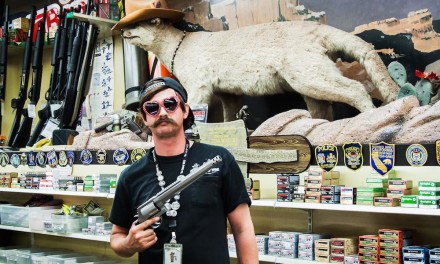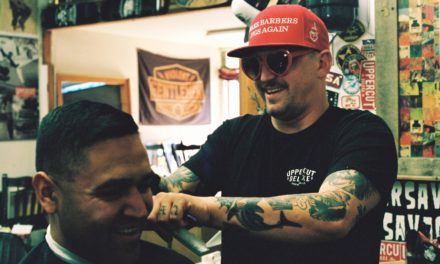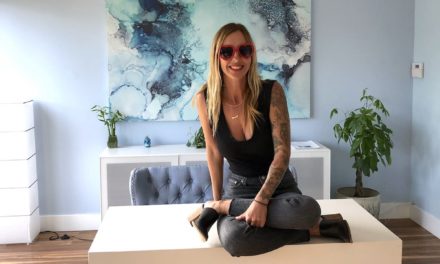
As another school year wraps up in The City Of The Arts – and Costa Mesa students count down the days until summer break – I Heart Costa Mesa headed down to the campus of Orange Coast College to learn more about their popular Visual & Performing Arts Program.
We wanted to see, firsthand, how this storied, local, community college is addressing the needs of budding student artists and honing the skills of our community’s next generation of creative contributors. We were fortunate to connect with a local artist-turned-professor to help navigate our way through all available aesthetic offerings.
Our guide was Eastside Costa Mesan, Chris Kerins, an artist, architect, illustrator, web designer, adjunct art instructor and – as of this coming fall – head of the Commercial Arts Program for Orange Coast College.
Artist About Campus: Chris Kerins on the Steps of the OCC Art Center

Kerins has a warm, affable way that makes him easily relatable, and he seemed enthusiastic to introduce us to the program. He’s also an “artist about campus” – simultaneously dabbling in numerous OCC visual departments.
“I teach in the Digital Media Arts & Design Department, the Architecture Department and now the Art Department,” said Kerins. “I’m also the Illustration Club advisor. With all of that going on, life definitely isn’t boring.”
Aside from teaching and mentoring, Kerins is a seasoned artist in his own right. He started off studying Architecture at Cal Poly San Luis Obispo which led to a job as a Walt Disney Imagineer doing conceptual architecture.
Eventually, the Burbank heat wore on Kerins and he yearned to return to the coastal Orange County of his childhood. He moved back and did a short stint with Steven Langford Architects, designing restaurants for Islands, Houston’s, CPK and the like – but it left him wanting.
“It was pretty cool work,” said Kerins. “But not as cool as designing The Little Mermaid ride at Disneyland, though!
“I figured out that the one thing show designers – they’re the ones designing attractions for Disney – had in common is they all had an Masters of Fine Art in Set Design. So I went back to school at UCLA to get my MFA in Set Design for theater, film and television.”
Kerins also took on projects that married his experience in both architecture and “imagineering,” like the theme hotels that were popping up all over Las Vegas in the 90’s.
“I worked with the guys who did Treasure Island and the Bellagio in Vegas,” said Kerins. “I also did some stuff in Macau. It was ‘concept art’ work – part set design, part architecture and part theming.”
Around that time, the internet boom hit, so Kerins taught himself web design and began taking on projects.
“When the dot-com boom happened, I couldn’t resist,” said Kerins. “I became an art director – and later the creative director – of a dot-com company in Marina Del Rey. Of course, when the economy went south, it all went bust. By now it’s 2001, I’m married and my wife’s pregnant. We decide to settle in and start looking for houses in Costa Mesa.”
Kerins’ house hunt eventually brought him to Eastside Costa Mesa.
“I’m allergic to ‘cookie-cutter,’ so we wanted an area with character. Eastside was definitely the closest thing to the cool vibe of, say, Pasadena,” said Kerins. “We fell in love with the neighborhood and have been here ever since. Around that time I also started two businesses that I still run today, out of my home studio: Atomic Blue Web Design and Real Color Architectural Illustration.
“Obviously, architectural illustration is heavily dependent on the real estate industry. When the market went kaboom in 2008, I suddenly had a lot of free time on my hands. So I came over to OCC and started teaching part-time. The rest is history.”


Students Busily Designing, Creating And Making Art At Orange Coast College in Costa Mesa

Before the 2008 crash, OCC wasn’t really on Kerins’ radar. But once he meshed with the college, he realized the school had been a peripheral presence in his life for a long time.
“When I was growing up in Huntington Beach, my dad came here for a photography class,” said Kerins. “Then, my mom came here for horticulture which led to a career in landscape architecture. Both my brothers went here, too.”
It was an adjustment for Kerins to shift gears from commercial artist to art instructor, but not an unwelcome change.
“For most of my adult life, the work has always been about helping somebody sell something,” said Kerins. “When you’re young, you’re hungry. You’re busy building a career and trying new things, so the selling part comes easily. But as I got older, I realized I really wanted to influence lives more than I wanted to sell another widget. Being able to do that at a junior college – where students are still very much finding their way – is incredibly fulfilling.
“At this point in my life, I am much more excited to come here and teach than I am to go design another website or illustrate another building.”
Up And Away: Kerins Find Great Satisfaction Helping Students Take Their Skills To The Next Level

Kerins is especially focused on commercial art – teaching the real-world, career-oriented applications of creativity.
“So the art program here at OCC has historically been pretty fine-art focused – painting, drawing, sculpture, illustration, ceramics – the core pillars of fine arts. But commercial art is where students can actually translate those skills into lucrative jobs, and we are trying to grow that side of our program, now.
“For example, think of how students today grew up watching Pixar and playing digitally-animated video games. The digital entertainment industry is so prevalent, the gaming industry is now bigger than Hollywood. We want to meet that demand and start our students off with the foundation they need to break into those industries.”
One subject Kerins teaches is a Rapid Visualization course, which is all about ideation. Students learn to sketch their ideas out in a fast, visual format so they’re more easily communicated and evaluated.
“Rapid viz is really about how to think with your pencil – or your computer – so you can get those ideas out of your head and into a format that can be shared with others,” said Kerins. “Say you have your initial thoughts, your concepts. Then you have to ask yourself, ‘How do I communicate them? How do I evolve them?’ We might fill four pages with sketches, but then quickly pick the best representations of our ideas. It’s a powerful skill that applies to so many visual industries.”
Whether rapid viz appeals to you – or you’d rather try one of the seemingly millions of other courses at OCC – Kerins encourages Costa Mesans to dabble at the community-college level.
“It’s a good, low-cost way to try some things on for size, to sample a bit,” said Kerins. “You may not be able to take eight product design classes here, but you can try your first product design class – with low barrier to entry – and then decide if it’s the right path for you.”
Impressive, Entertainment-Design Samples From Some Of Kerins’ Former Students

Kerins’ dedication to influencing the lives of budding artists doesn’t stop when the school year does. He also helps coordinate an annual “study abroad” trip open to anyone in the community (over age 18) with the means and desire to go.
“Next year we’re thinking Paris – but this year, we’re going to Rome,” said Kerins. “I teach the sketching portion of the program and I have a partner who teaches photography. That way, you get two perspectives.
“Imagine being in the piazza in front of the Pantheon, sketching in a cafe while you drink your espresso. We live there for a month, we shop with the locals, we explore, we sketch or photograph what we see. You’re probably going out in the evenings with fellow students. It’s all about leaving the tour bus behind and really living the life, breathing in the culture.
“Students get to immerse themselves in the art, the history and the culture of the place. And it’s open to anyone over 18, so I hope your readers will look into joining us, next year.”

When he’s not sketching his way through Rome or Paris, what does Kerins most enjoy about being home in Costa Mesa?
“I live here because of the city’s open, eclectic nature and the kinds of residents it attracts,” said Kerins. “I drive by a house on 20th Street all the time because they are always rebuilding classic cars. Costa Mesa, particularly Eastside, seems to be open to quite a variety of things – architecture, types of people, etc. – which I really like.
“I also think Westside is headed in the right direction. It’s got a pulled-up-by-the-bootstraps kind of scrappiness about it, which has a really attractive quality for artists. We love that kind of thing.
“I do get a little discouraged when the city calls itself ‘The City Of The Arts’ then usually just points to Segerstrom. Don’t get me wrong, it’s great that Mr. Segerstrom supported the arts and did so much for the city. We are fortunate to have the performing arts center in Costa Mesa – but it’s almost like an island within our city. I can’t help but think, ‘What about the rest of Costa Mesa? The rest of the artists?’
“If we had new art venues all over the city – College Park, Mesa Verde, South Coast, Eastside, Westside, over by the airport – I think it would do more to solidify us as a place that values art and artists.
“I would love to see more ‘CoLab’ workspaces around town, they are great incubators for art. We want to start one here, on campus – a multi-disciplinary space with a wood shop, metal shop, digital fabrication, robotics, electronics, the whole thing. Our end goal is for it to be integrated into the community, part academic and part community/business driven. We’re a college so we have the resources to do that, but it would be cool to see little seedlings of that idea all over the city.
“I think someday, we will get there. Costa Mesa is full of people who appreciate ideas like that, people who aren’t scared off by diversity. Sure, we’ve got shiny edges and we’ve got rough edges – but this city is always interesting and there’s always something going on.” ♥




